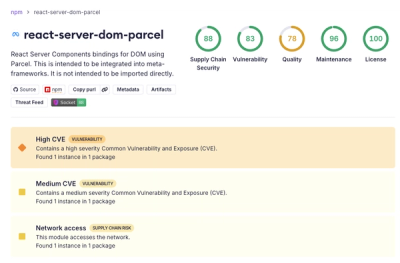
Security News
Deno 2.6 + Socket: Supply Chain Defense In Your CLI
Deno 2.6 introduces deno audit with a new --socket flag that plugs directly into Socket to bring supply chain security checks into the Deno CLI.
webpack-merge
Advanced tools
webpack-merge provides a merge function that concatenates arrays and merges objects creating a new object. If functions are encountered, it will execute them, run the results through the algorithm, and then wrap the returned values within a function again.
This behavior is particularly useful in configuring webpack although it has uses beyond it. Whenever you need to merge configuration objects, webpack-merge can come in handy.
merge(...configuration | [...configuration])merge is the core, and the most important idea, of the API. Often this is all you need unless you want further customization.
const { merge } = require('webpack-merge');
// Default API
const output = merge(object1, object2, object3, ...);
// You can pass an array of objects directly.
// This works with all available functions.
const output = merge([object1, object2, object3]);
// Keys matching to the right take precedence:
const output = merge(
{ fruit: "apple", color: "red" },
{ fruit: "strawberries" }
);
console.log(output);
// { color: "red", fruit: "strawberries"}
Note that Promises are not supported! If you want to return a configuration wrapped within a Promise, merge inside one. Example: Promise.resolve(merge({ ... }, { ... })).
The same goes for configuration level functions as in the example below:
webpack.config.js
const commonConfig = { ... };
const productionConfig = { ... };
const developmentConfig = { ... };
module.exports = (env, args) => {
switch(args.mode) {
case 'development':
return merge(commonConfig, developmentConfig);
case 'production':
return merge(commonConfig, productionConfig);
default:
throw new Error('No matching configuration was found!');
}
}
You can choose the configuration you want by using webpack --mode development assuming you are using webpack-cli.
mergeWithCustomize({ customizeArray, customizeObject })(...configuration | [...configuration])In case you need more flexibility, merge behavior can be customized per field as below:
const { mergeWithCustomize } = require('webpack-merge');
const output = mergeWithCustomize(
{
customizeArray(a, b, key) {
if (key === 'extensions') {
return _.uniq([...a, ...b]);
}
// Fall back to default merging
return undefined;
},
customizeObject(a, b, key) {
if (key === 'module') {
// Custom merging
return _.merge({}, a, b);
}
// Fall back to default merging
return undefined;
}
}
)(object1, object2, object3, ...);
For example, if the previous code was invoked with only object1 and object2
with object1 as:
{
foo1: ['object1'],
foo2: ['object1'],
bar1: { object1: {} },
bar2: { object1: {} },
}
and object2 as:
{
foo1: ['object2'],
foo2: ['object2'],
bar1: { object2: {} },
bar2: { object2: {} },
}
then customizeArray will be invoked for each property of Array type, i.e:
customizeArray(["object1"], ["object2"], "foo1");
customizeArray(["object1"], ["object2"], "foo2");
and customizeObject will be invoked for each property of Object type, i.e:
customizeObject({ object1: {} }, { object2: {} }, bar1);
customizeObject({ object1: {} }, { object2: {} }, bar2);
customizeArray and customizeObjectcustomizeArray and customizeObject provide small strategies to for mergeWithCustomize. They support append, prepend, replace, and wildcards for field names.
const { mergeWithCustomize, customizeArray, customizeObject } = require('webpack-merge');
const output = mergeWithCustomize({
customizeArray: customizeArray({
'entry.*': 'prepend'
}),
customizeObject: customizeObject({
entry: 'prepend'
})
})(object1, object2, object3, ...);
unique(<field>, <fields>, field => field)unique is a strategy used for forcing uniqueness within configuration. It's most useful with plugins when you want to make sure there's only one in place.
The first <field> is the config property to look through for duplicates.
<fields> represents the values that should be unique when you run the field => field function on each duplicate.
When the order of elements of the <field> in the first configuration differs from the order in the second configuration, the latter is preserved.
const { mergeWithCustomize, unique } = require("webpack-merge");
const output = mergeWithCustomize({
customizeArray: unique(
"plugins",
["HotModuleReplacementPlugin"],
(plugin) => plugin.constructor && plugin.constructor.name,
),
})(
{
plugins: [new webpack.HotModuleReplacementPlugin()],
},
{
plugins: [new webpack.HotModuleReplacementPlugin()],
},
);
// Output contains only single HotModuleReplacementPlugin now and it's
// going to be the last plugin instance.
mergeWithRulesTo support advanced merging needs (i.e. merging within loaders), mergeWithRules includes additional syntax that allows you to match fields and apply strategies to match. Consider the full example below:
const a = {
module: {
rules: [
{
test: /\.css$/,
use: [{ loader: "style-loader" }, { loader: "sass-loader" }],
},
],
},
};
const b = {
module: {
rules: [
{
test: /\.css$/,
use: [
{
loader: "style-loader",
options: {
modules: true,
},
},
],
},
],
},
};
const result = {
module: {
rules: [
{
test: /\.css$/,
use: [
{
loader: "style-loader",
options: {
modules: true,
},
},
{ loader: "sass-loader" },
],
},
],
},
};
assert.deepStrictEqual(
mergeWithRules({
module: {
rules: {
test: "match",
use: {
loader: "match",
options: "replace",
},
},
},
})(a, b),
result,
);
The way it works is that you should annotate fields to match using match (or CustomizeRule.Match if you are using TypeScript) matching your configuration structure and then use specific strategies to define how particular fields should be transformed. If a match doesn't exist above a rule, then it will apply the rule automatically.
Supported annotations:
match (CustomizeRule.Match) - Optional matcher that scopes merging behavior to a specific part based on similarity (think DOM or jQuery selectors)append (CustomizeRule.Append) - Appends itemsprepend (CustomizeRule.Prepend) - Prepends itemsreplace (CustomizeRule.Replace) - Replaces itemsmerge (CustomizeRule.Merge) - Merges objects (shallow merge)webpack-merge supports TypeScript out of the box. You should pass Configuration type from webpack to it as follows:
import { Configuration } from "webpack";
import { merge } from "webpack-merge";
const config = merge<Configuration>({...}, {...});
...
nvm usenpm inpm run build -- --watch in one terminalnpm t -- --watch in another oneBefore contributing, please open an issue where to discuss.
Check out SurviveJS - Webpack 5 to dig deeper into webpack. The free book uses webpack-merge extensively and shows you how to compose your configuration to keep it maintainable.
I am also available as a consultant in case you require specific assistance. I can contribute particularly in terms of improving maintainability of the setup while speeding it up and pointing out better practices. In addition to improving developer productivity, the work has impact on the end users of the product in terms of reduced application size and loading times.
This project exists thanks to all the people who contribute. [Contribute].
Become a financial contributor and help us sustain our community. [Contribute]
Support this project with your organization. Your logo will show up here with a link to your website. [Contribute]
webpack-merge is available under MIT. See LICENSE for more details.
6.0.1 / 2024-07-02
clone-deep as there was a corner case where structuredClone did not work as expected. #214deepmerge is a library that can deeply merge multiple objects into one. While it's not specific to webpack configurations, it can be used for a similar purpose. However, webpack-merge offers webpack-specific merging capabilities that deepmerge does not, such as smart merging of loaders and plugins.
lodash.merge is a method from the Lodash library that provides a deep merge of objects. Similar to deepmerge, it can be used to merge webpack configurations but lacks the webpack-specific intelligence of webpack-merge, potentially requiring more manual configuration for complex webpack setups.
FAQs
Variant of merge that's useful for webpack configuration
The npm package webpack-merge receives a total of 14,839,732 weekly downloads. As such, webpack-merge popularity was classified as popular.
We found that webpack-merge demonstrated a not healthy version release cadence and project activity because the last version was released a year ago. It has 0 open source maintainers collaborating on the project.
Did you know?

Socket for GitHub automatically highlights issues in each pull request and monitors the health of all your open source dependencies. Discover the contents of your packages and block harmful activity before you install or update your dependencies.

Security News
Deno 2.6 introduces deno audit with a new --socket flag that plugs directly into Socket to bring supply chain security checks into the Deno CLI.

Security News
New DoS and source code exposure bugs in React Server Components and Next.js: what’s affected and how to update safely.

Security News
Socket CEO Feross Aboukhadijeh joins Software Engineering Daily to discuss modern software supply chain attacks and rising AI-driven security risks.